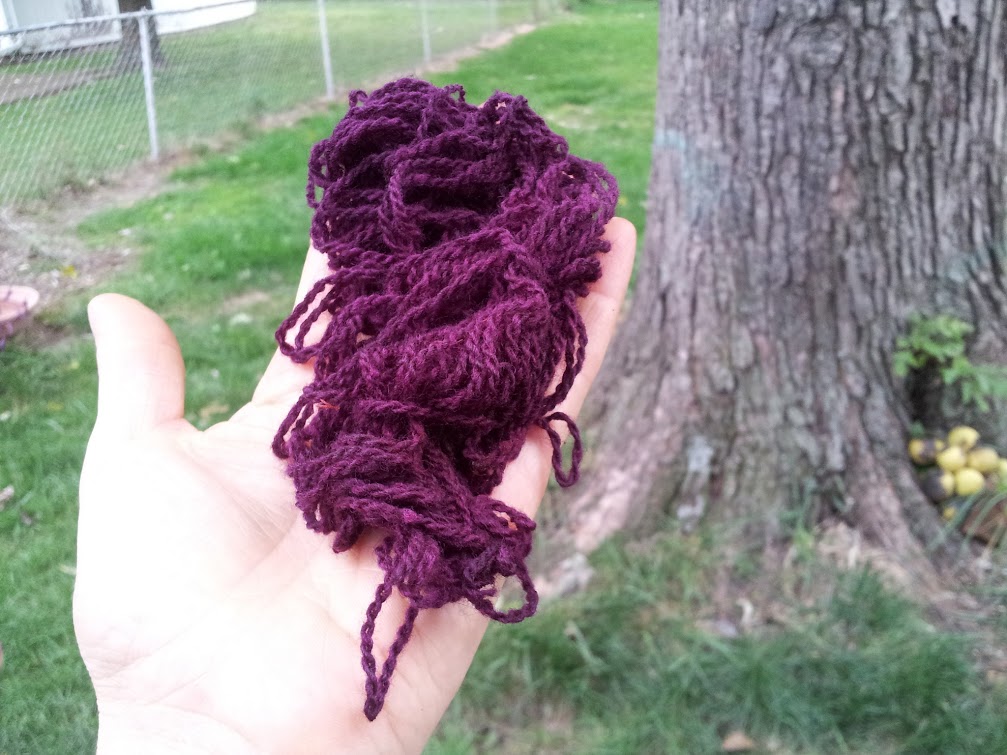At the Burrow DyeTable # Six: Poke for Pia
My fiber friend, Pia, asked me to do a little experiment for her. She asked me to do a cold dye process with the pokeberries. And so I did. After all, far be it from me to ignore an opportunity to experiment, to leave our curiousity hanging. Thank you, Pia, for your request. I would not have thought to run a cold dyebath with pokeberries.
Dye Notes:
Dyestuff: Pokeweed (phytolacca americana)
Parts used: The berries
Source: My yard, the Haggencrone’s yard, a friend’s yard, and the farm
Yarn: Mountain Meadows Cody mordanted in vinegar as per the instructions in Harvesting Color by Rebecca Burgess.
Ratio of dyestuff to fiber: No clue. These were some of the pokeberries preserved in vinegar that wouldn’t fit in the original poke dyepot. So I left them in a Mason jar. I’d guess maybe 200g of berries. Maybe more, maybe less. Hard to tell. The little mini-skein of yarn weighs 6g.
Extraction: Mashed the berries in white distilled vinegar and left them for a month out of the sunlight.
Dyebath: Cold dyed in a Mason jar. No sunlight. Nine days.

The results?
The top of the dye liquid formed a white film. Some kind of funk. It didn’t really smell bad, though, nor did it seem to effect the colour below. The funk rinsed off easily and didn’t seem to do anything negative to the yarn.
Boy, is this yarn purple. I mean PURPLE, like whoa.

It only got a little bit lighter with rinsing in plain tapwater. It is a gorgeous colour. And I am thankful to Pia for asking me to do this little experiment so that I could learn about yet another colour from the poke’s most unredundant bounty.
This is my favourite yet.
 We’ll see if the colour lasts. If so, this is my new go-to way to dye with pokeberries, hands down. Pia, I hope you are happy with the pokeberry results, too. :D
We’ll see if the colour lasts. If so, this is my new go-to way to dye with pokeberries, hands down. Pia, I hope you are happy with the pokeberry results, too. :D
Live happy, dye happy!




That’s just friggin ….. just awesome. I’m not a purple person, but this is gorgeous. Love love, thanks for jumping to the task! I’m SO going to find a source for poke! Amazing how you can get different shades from just one plant, isn’t it?
Purple’s not usually my thing either, but this one really has a great depth of colour. And when it comes from your own dyepot, it’s hard not to love it. I’m really amazed not only by the results from the pokeberry dyepots, but also by how much fun it is to work with at every step of the process. I hope you find some.
Wow, that came out really pretty!
Thank you! I am pleased. I love it when these things work out.
As you can probably guess, I’m not a dyer or someone who knits, but you make it sounds so interesting. And I love the process and colors you come up with.
Thank you very much. I appreciate the kind words and that you took the time to read about the process. Hope you are doing well. Can’t wait until you are posting again. Cheers!
Oh my gosh, it’s really beautiful! I never thought natural dye make deep purple like that. I’ve never seen pokeweed before – lived in city all the time – so it is really amazing for me. Thank you for good experiment!
Thank you!
Congrats on the results!
Interesting to see how lightfast it is. Please, keep informing of this experiment!
I enjoy reading your blog a lot! Thanks,
Cheers,
xo
Thanks! I’ll post the lightfastness results as soon as they’re done.
I’m also interested in the lightfastness. I can’t recall if I’ve seen pokeberry in Northern California, or not….
The lightfastness test is hanging in a south-facing window now. It needs another 2 weeks, and it will be ready. I’ll post results then.
Wonderful colour! I used to have lots of pokeberries in my summer house, but never tried to dye with them because of ignorance. I’ve bookmarked a blogpost, in hope I’d stumple upon some plants again: http://hillcreekfiberstudio.blogspot.dk/2011/04/non-fading-pokeberry-recipe.html
Maybe it can be of some interest for you.
Thank you!
Hello! I’ve just discovered your blog and i have to say, the wealth of detailed experimentation going on around your place is fantastic! Thanks so much for sharing it all… I’m in southern Australia and recently discovered a species of Phytolacca (octandra?) growing as a weed here… I haven’t been able to find any reference to it as a dye plant but the juice of the berries certainly dyed my tshirt and skin ;) the first time, I only had a handful but followed Rebecca Burgess’ instructions for vinegar mordanting and extraction with only a very pale gold colour resulting. It could have been the tiny quantity of material but I feel like heating wasn’t the right way to dye them as the pink disappeared during extraction. I thought I’d try solar dyeing them in vinegar and then, hunting through google, found your blog!
I hope its ok that I put to you a couple of questions? Do you think it is still important to premordant in vinegar, given that the yarn will be steeped in the vinegar solution for quite a long time? Is it this pre-exposure to vinegar that helps it take up colour?
And is there any reason you left the berries steeping in vinegar in the sun but the yarn in the extraction out of the sun? I hoped to use our weak autumn sun to support the dyeing process as I don’t have a warm spot out of the sun to put the jar.
Thanks! And thank you also for your eloquent and down-to-earth post on your struggle with anxiety. I too have a hard time with it and often find the management of daily life exhausting and overwhelming… I don’t really share my experiences with many of the people around me and have always felt that writing about it on my blog would be too confronting for me and those who read it! Perhaps it would be good to be more open about it…
Anyway, thanks for all and hope you’ve got some good dyeing on the cards!
Jules xx
Thanks for the kind words, Jules! And, I love questions! So, first of all, I’ve read about the type of phytolacca that you all have in Australia, and I think that it should work similarly to the variety we have here in the States. After all, octandra is known as “red inkplant” or “inkweed”. Sounds promising, right? As for your results, quantity definitely might have been an issue. But I’d also like to know how hot your extraction was? It’s pretty heat sensitive. I didn’t go above 180F. Definitely no boiling (or even simmering, really).
All of the poke extractions were done OUT of the sun. No sunlight. I don’t think that heat is necessary in this case for the uptake. Room temp is fine. I think it is all time and pH.
It would be interesting for you to experiment and see if premordanting is truly necessary before a long, cold-dyeing process in vinegar. I’m sure that it is necessary for the heated process, but am not sure if it is otherwise. The only thing that I can think is that the premordanting might open up the scales of the wool to prepare it for immediate uptake of the dye. I just don’t know. And, I wonder how lightfastness would be effected if you didn’t premordant first—even though the cold dyebath was far superior in the lightfastness test. Only one way to find out…
Thanks so very much for your reply a few weeks ago- so sorry for the very belated reply! Was really great to get your feelings and ideas about the cold poke bath! I’m almost at a month of soaking the berries so am getting ready to add the yarn :) I think I’ll add some unmordanted and some premordanted yarn to see if there is any difference and will let you know the results!
Happy day xx
Dyeing to know how colorfast these were, two years later. Please post an update. I love dyeing with poke, but I’m new to all this and didn’t think look into whether it will be colorfast when i started. Now I’m wondering how long my yarn will stay purple. It’s been nine months so far. And that was with an alum mordant.
A few years late, but thanks so much for your detailed testing of dyeing with pokeweed. I had tried this eons ago (pre-Internet), following the advice of Rita Buchanan and the Brooklyn Botanical Garden. But I don’t recall anyone suggesting a cold dye bath. It works great! Your notes and photos are fantastic!
Thank you so much! Glad it helped. :D
The film is also known as kam yeast and it’s fairly common especially among those who ferment things. You are right, it’s harmless! :)